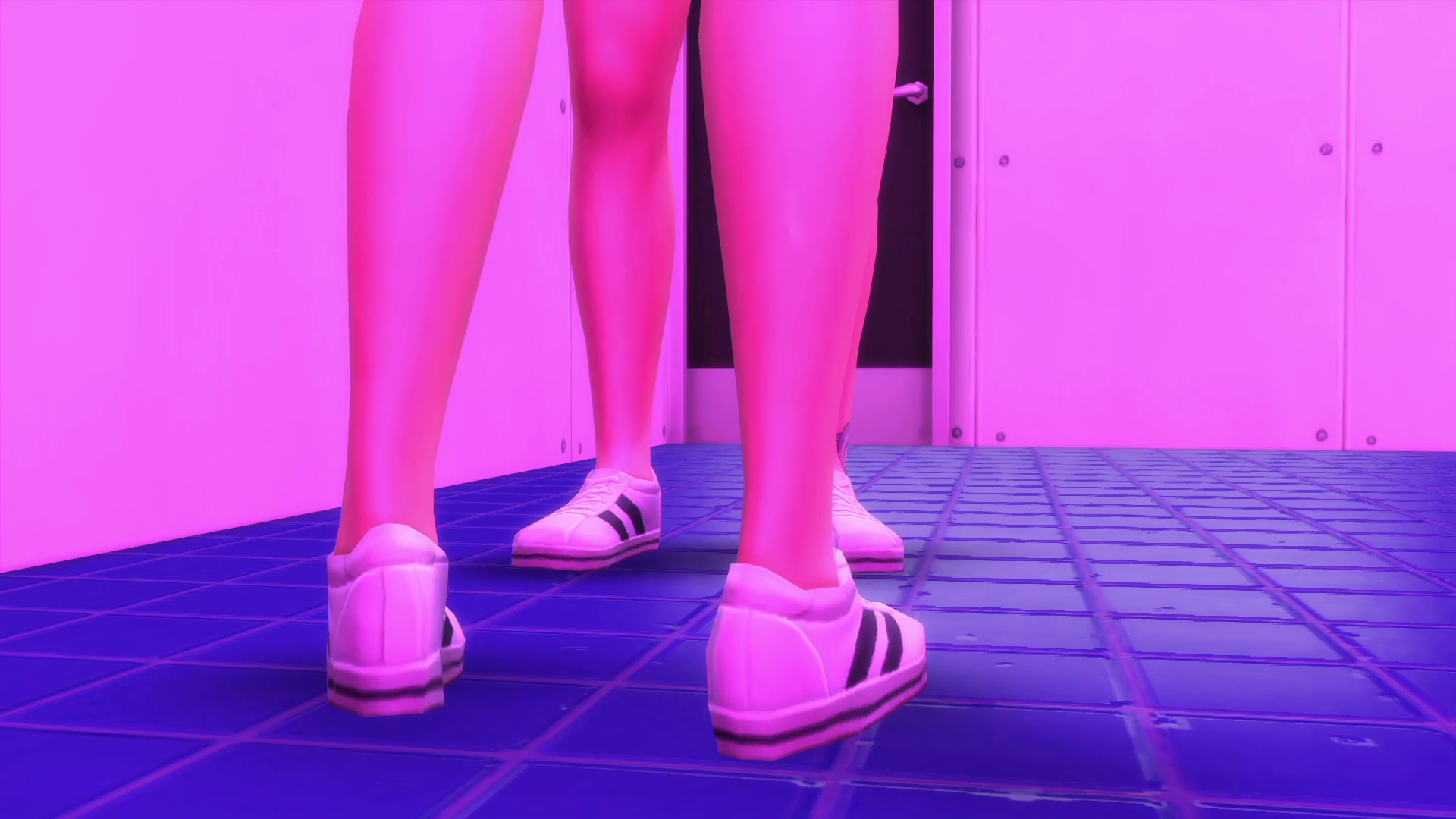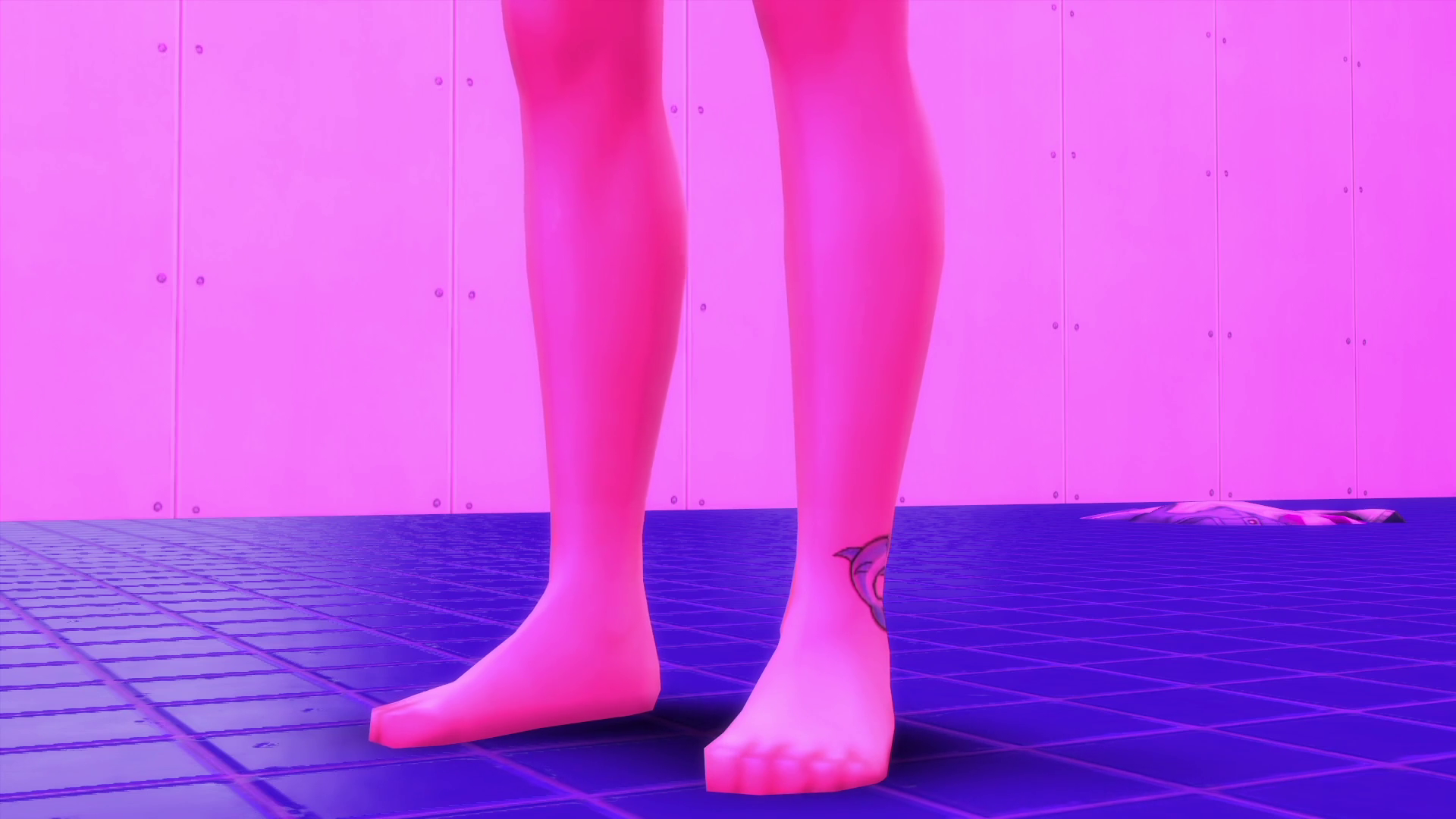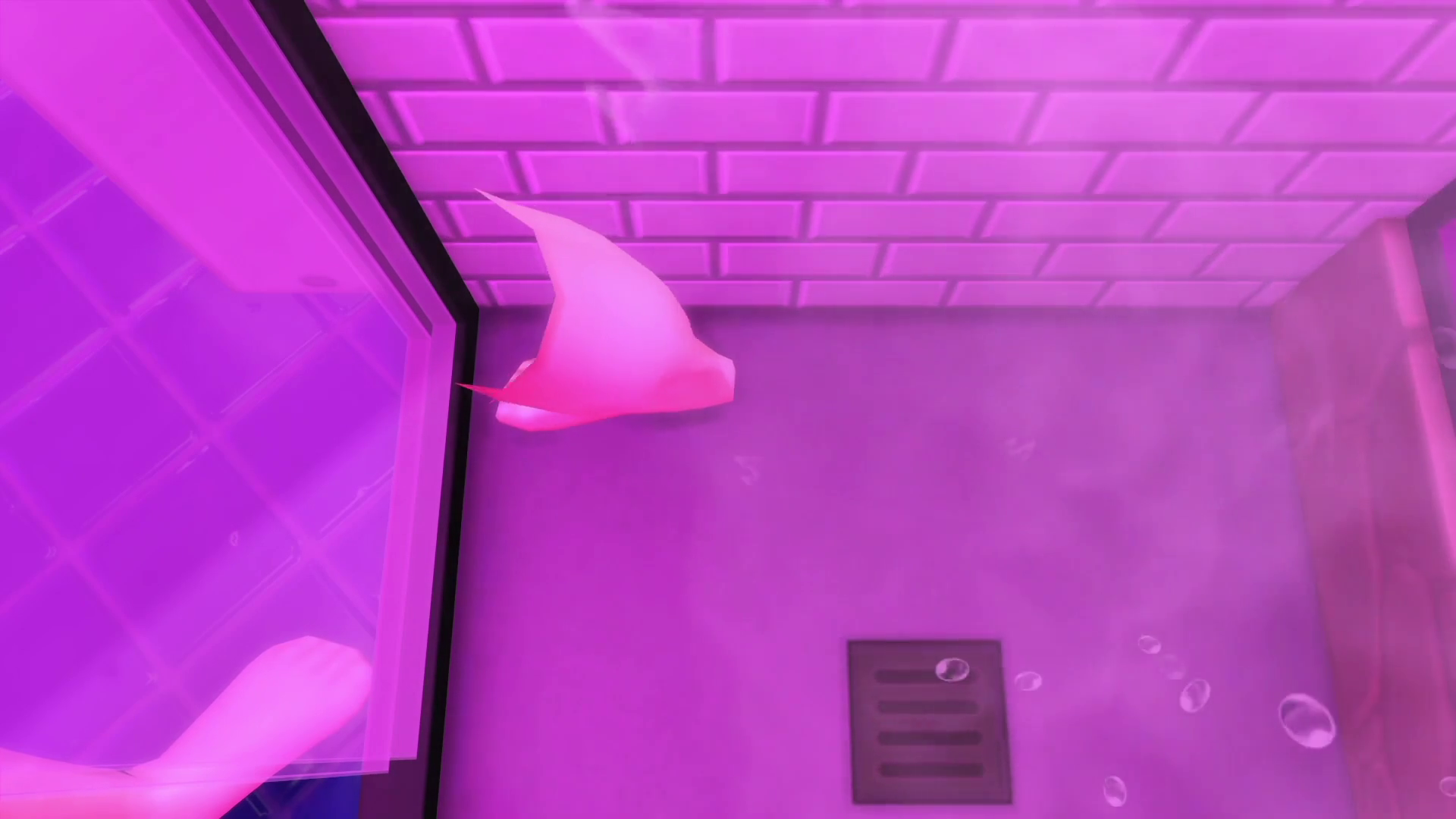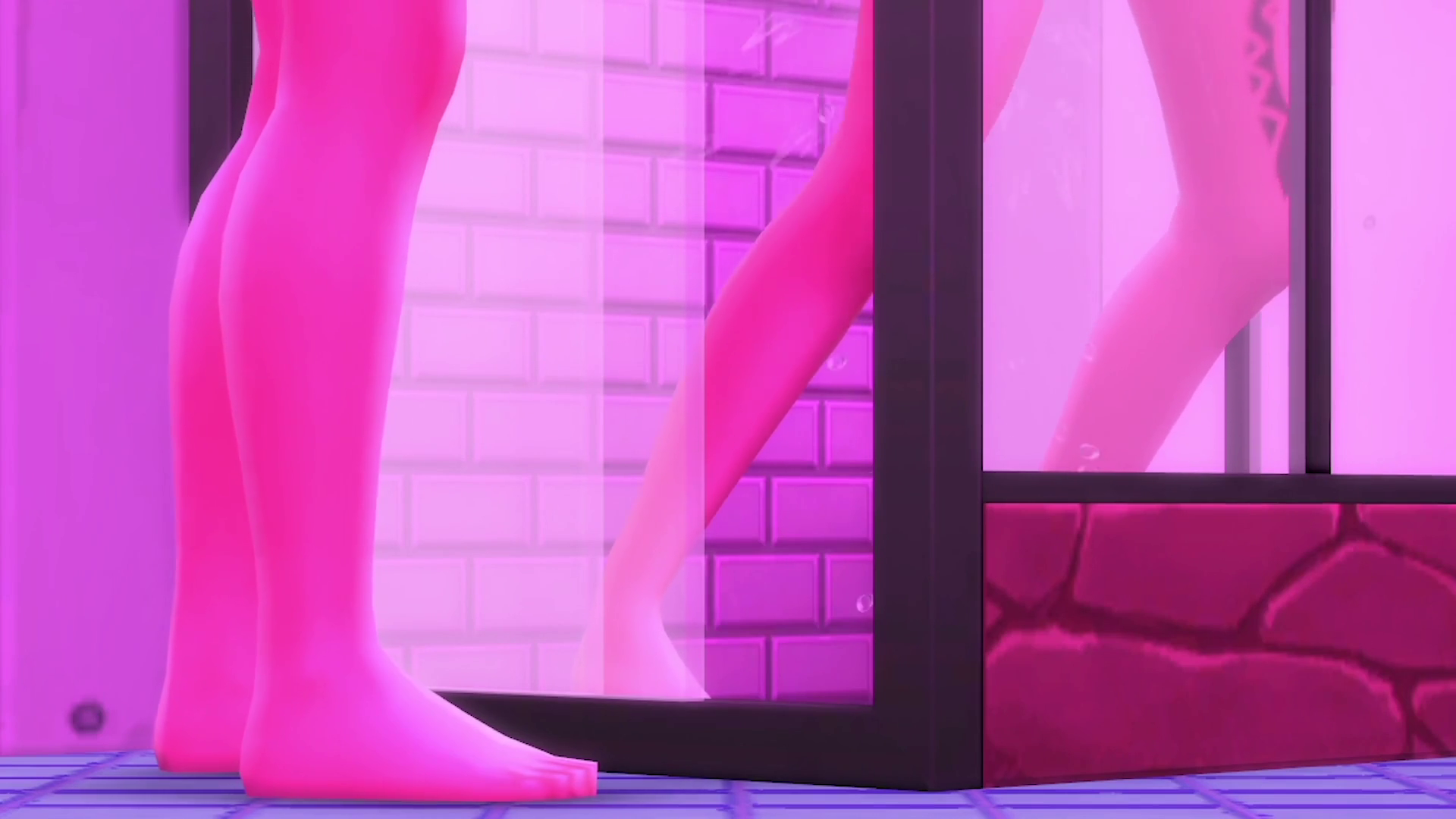FEDERICA DI PIETRANTONIO
GAME VIDEO ESSAY
MARCH 21-27 2022/21-27 MARZO 2022 (ONLINE)
Introduced by Gemma Fantacci
MADE IN ITALY
MARCH 26 2022/26 MARZO 2022 (MIC, IN SITU)
Introduced by Gemma Fantacci
THERES GLITTER ON THE FLOOR
machinima/digital video, color, sound, 3’ 50”, 2021, Italy
Gli avatar possono sentirsi nudi? Qual è la relazione tra il corpo di un avatar e quello di un giocatore? theres glitter on the floor è un cortometraggio realizzato con/in The Sims 4 che esamina la nozione di corporeità negli spazi ludo-digitali.
Can avatars feel naked? What’s the relationship between the body of an avatar and the body of a player? theres glitter on the floor is a short-film made with/in The Sims 4 that investigates the notion of corporeity within gaming spaces.
L’ARTISTA
THE ARTIST
Federica Di Pietrantonio è nata a Roma nel 1996 e ha studiato pittura all’Università di Belle Arti di Roma. Dopo aver conseguito la laurea nel 2019, ha svolto una residenza a KASK (Ghent, Belgio), dove ha sviluppato il progetto Vacation Spot con The Sims. Nel 2017, Di Pietrantonio è stata selezionata per Mediterranea 18 Young Artists Biennale e l’anno successivo ha iniziato una collaborazione con Spazio In Situ come artista e web designer. Le sue opere sono state esibite in Italia, Belgio e Portogallo. Vive e lavora a Roma.
Federica Di Pietrantonio was born in Rome in 1996. She studied painting at the University of Fine Arts in Rome. After receiving her B.A. in 2019, she did a residency at KASK (Ghent, Belgium), where she developed the project Vacation Spot with The Sims. In 2017, Di Pietrantonio was selected for Mediterranea 18 Young Artists Biennale and the following year she began a collaboration with Spazio In Situ as an artist and web designer. Her work has been exhibited in Italy, Belgium, and Portugal. She lives and works in Rome.
THERES GLITTER ON THE FLOOR
machinima/digital video, color, sound, 3’ 50”, 2021, Italy
INTERVIEW
Gemma Fantacci: theres glitter on the floor strongly reminds me of a work of early Italian cinema made by the Ambrosio studio of Turin. I am referring to Amor Pedestre (1914), directed and interpreted by Marcel Fabre, remade as a machinima with glitches. Is my reading out of whack or did I discern some intentional affinities?
Federica di Pietrantonio: I must confess that I was unaware of the film you mention and appreciate the reference. The decision to focus on the lower part of the avatars’ bodies gave me the chance to craft the narrative on different levels. This perspective makes it impossible for the viewer to discern the real identity of the characters (Mucca and Pollo). At the same time, their gestures show that they are actively speaking to each other, which cannot be presumed either from the audio or from their faces. In my videos, as in my paintings, I tend to hide the whole narrative or the full story behind artistic or aesthetic choices. I believe that the narrative potential lies not in what the images or frames show, but in what we assume is happening, as a construct of the imagination following artistic creation, if we want it to be an imaginative construct. What looks like a glitch — thus the visualization of an error or malfunction — is indeed the actual image of the volume and textures of the avatars, so that the virtual camera matches their “eyes”. By doing so, I try to achieve implausible or unfeasible views for “conventional” human sight, assuming a mode of observation disconnected to physical experience.
The title of the video is a direct quotation of a song by Rizha, GLITT3R: “theres glitter on the floor I wish I didn’t notice”, which alludes to the desire for understanding reality through its observation, and at the same time, the fear of fully grasping the insights that come with it.
Gemma Fantacci: In theres glitter on the floor we only see a portion of the avatar’s body and a specific section of the frame: the ground/floo and the lower parts of the characters. This peculiar perspective is very different from what the audience generally associates with identity, which requires some kind of identitication: the face, a gaze, and so on. Can you elaborate on your stylistic and aesthetic choice? How did you frame the relationship between the artist-player and the virtual characters?
Federica di Pietrantonio: In my last few video works, I have been experimenting with different camera angles. In theres glitter on the floor, for example, there are shots where the camera is outside the avatars and shots where the camera coincides with their “eyes” — that is, their POV. In the former, I can oversee the scene from points of view that would be physically impossible or extremely complex to shoot, I can anchor myself to any virtual point in space. The latter, on the other hand, presents views from the inside out, revealing spatial structures reminiscent of x-rays or other kinds of machine vision. In addition to space, time is a key variable in scene management. While shooting, I can stop and change my point of view, examine the avatar as if it were a sculptural form, or rather as if each frame was statuesque in nature, independent and yet, at the same time, ephemeral and transient. Pausing the game brings the mediumn of scultpure into the game, both aesthetically and formally, externalizing the composition in space in a single unit of time and freezing the action, giving the director the chance possibility to observe the scene from any point of view. Every time I engage with a video game I try to understand my interaction with the avatar, the members of a community, and the space itself, accepting the implications and constraints related to technical factors, trying to reach into the unknown with curiosity, fear, and amazement.
Gemma Fantacci: Your artistic practice focuses on the two media, painting a gaming. You explored this relationship via the The Sims in your previous project Vacation Spot. Why this emphasis on The Sims? Can you elaborate on how you look at the interaction between the digital and the concrete?
Federica di Pietrantonio: I spent so much time with/in The Sims. This game was a staple when I was growing up and it still occupies a special place in my imagination. It feels familiar, and thus pleasant. When I talk about it, it’s hard for me to find the most appropriate words, because this space is both personal and emotional. It is also a space for artistic experimentation and conceptual tinkering. I have always been fascinated by the idea that we commonly associate virtual space with a second degree reality, a simulation of reality, a copy of the here and now, an augmented layer of existence and so on... and only rarely, or in specific environments, we look at virtual space as a distinct reality, which may reference lived reality and yet it is independent from it. The Sims, as a real life simulation game introduced more than twenty years ago expresses this paradox ironically, but at the same time with some kind of deference to the established, canonical conventions of perspective and representation. I also believe that the real power of online platforms, video games and so on it not related to their technical features as much as their social capital. In short, it’s people, no technology, that matter. These games are great at creating communities whose members share strong bonds. These ties are not purely social and cultural in nature, but also critical and conceptual. This can be seen both in the efforts behind their construction and preservation, as these communities are always on the bring of oblivion.
Precisely because my relationship with the virtual is based on imagination — or rather because I consider imagination to be a sandbox, and thus related to the virtual — the exchange between the concrete and the digital does not entail contrast between two media, but rather between two different modes of thinking. In this way, on a speculative level, a painting could also be digital and machinima could be defined analogue.
Gemma Fantacci: The performative act within theres glitter on the floor refers to the assumptions underlying the representation of the human body. Do you think the avatars and the game world are “autonomous” entities, or that the player acts as a sort of demiurge within a simulation, exerting total control?
Federica di Pietrantonio: This is something that I constantly ask myself. My answer is… both. We often unconsciously project our identity to that of a superhuman entity managing an entire world, a demiurge that can build, destroy, transform it at will. But what if the effect of creation is astonishing? I believe that the affective dimension of our relationship to virtual reality is crucial when it comes to feeling like a God or a mere observer within digital spaces. What is our level of emotional involvement with virtual life, beyond our semi-divine control?
Gemma Fantacci: Aesthetically speaking, the lack of identity and social distinction between the two characters in theres glitter on the floor produces an uncanny effect on the viewer, a sense of simultaneous familiarity and estrangement. Was this effect unintended or deliberate?
Federica di Pietrantonio: The uncanny is a central concern of a project that I am currently developing, which focuses on the ontology of the avatar. How much is their existence autonomous and independent or inseparably connected to ours? What I find extremely stimulating are videos for practicing eye contact, out of which I try to collect the sensations of discomfort, cringe, contemplation, accustoming the eye to a vision that we escape, that we are afraid to keep or only attempt, re-elaborating them in virtual contexts. While directing, I try to approach and take inspiration from the ASMR (autonomous sensory meridian response) culture, reasoning on how moving images and sound create unexpected and physically present sensations on the body. Approaching this practice through media defined as digital or virtual is certainly a gesture that seeks to claim the independence of the virtual body as an autonomous identity. The regular human gaze is still afraid to publicly acknowledge virtual bodies as actively acting upon our emotions and corporality. I also wonder for how long we will try to achieve our ideal image through a representation filtered by human aesthetic standards and not through the creation of new aesthetics far from anthropomorphism.
Gemma Fantacci: The avatar allows us to express ourselves and our personality and The Sims is one of the game environments that offers an almost endless customisation of the self, thanks also to the wide range of mods created by players. However, there is also another kind of relationship between the player and the sims: the possibility to exercise their free will without any kind of restraint or limitation, deliberating on every aspect of their lives, from social relationships to the management of their physical needs. Within a media landscape in which the relationship with the avatar is conceived in terms of otherness or as an extension of the self, where does the recognition of the virtual body as a sentient subject fit in?
Federica di Pietrantonio: We have reached a point — I take 2004 as an approximate date when David Sorey bought a 25-square-kilometer plot of land for 26,500 dollars on Second Life — where we only have a rather limited sense of what it means to be a virtual citizen. The representation of the body — as well as the societal and economic systems within the different virtual environments — define and confirm the degree of reality, not involving fantasy and imagination. I often wonder about our independence from our virtual identities and vice versa, how independent our virtual identity is from us. It is a search that indirectly, looking back at some of my works, remains an unspoken issue. Sometimes it is linked to the representation of the body, others to features that are not strictly visual, such as the voice or the handwriting. On one level it seems to be a process aimed at externalization, at the fear of the oblivion of death, at the dissolution of the self; on the other it is an attempt to translate one’s identity into a digital entity that could absurdly become independent of the creator, an unconscious act of archaeological preservation of ourselves.
INTERVISTA
Gemma Fantacci: Il tuo lavoro mi ha ricordato molto un’opera del cinema delle origini italiano realizzato dallo studio Ambrosio di Torino. Mi riferisco ad Amor Pedestre (1914), diretto e interpretato da Marcel Fabre, ivi ripensato in chiave machinima, ma con l’elemento inedito delle glitch. La mia lettura è ardita oppure c’è qualche tangenza non casuale?
Federica di Pietrantonio: Confesso che non conoscevo questo riferimento e ti ringrazio per averlo condiviso! La scelta di riprendere solo parzialmente i corpi è un modo che mi permette di affrontare la narrazione secondo diversi livelli. Per esempio, non è possibile risalire all’identità completa delle persone (Mucca e Pollo), dalla gestualità traspare l’idea che i due personaggi stiano conducendo un dialogo, non presumibile né dall’audio né dalla presenza del viso e quindi del labiale. Spesso nei video, come nelle pitture, cerco di non far emergere tutta la narrazione o il racconto sottesi alla regia o alla scelta dell’immagine. Credo che la maggior parte del potenziale narrativo risieda non in quello che le immagini o i frame raccontino, ma in quello che presumiamo stia accadendo, come un costrutto dell'immaginazione che segue la creazione artistica, se vogliamo anch’essa un costrutto immaginativo. Quello che nel video esteticamente appare come glitch, e quindi sembra essere un errore di visualizzazione o malfunzionamento, è in realtà l'immagine effettiva del volume e delle texture degli avatar, facendo coincidere la camera con i suoi “occhi". In questo modo cerco di raggiungere visioni non abituali per l‘occhio umano, assumendo una modalità di osservazione non derivata dall’esperienza fisica. Il titolo del video è un riferimento alle lyrics di “GLITT3R” di Rizha: “theres glitter on the floor I wish I didn’t noticed” — il desiderio di voler comprendere la realtà attraverso la sua constatazione, ed allo stesso tempo la paura di poter comprendere rivelazioni da essa derivate.
Gemma Fantacci: Nella tua opera mostri solo una parte del corpo dell’avatar e una sezione specifica dell’immagine: il suolo/pavimento, la parte— in genere — più bassa di quando si filma un corpo eretto. Questi focus sono lontani da ciò che un pubblico, generalmente, associa a una identità, a un processo di riconoscimento (il volto, uno sguardo, ecc.). Qual è il significato di questa scelta stilistica ed estetica? Come si riconfigurano i rapporti identitari tra l’artista-giocatore e i personaggi dei mondi digitali?
Federica di Pietrantonio: Negli ultimi video sto sperimentando diverse modalità di ripresa con il punto di vista della camera. In theres glitter on the floor, per esempio, ci sono riprese in cui la camera è esterna e riprese in cui la camera coincide con gli “occhi” degli avatar. Con la prima modalità posso supervisionare la scena da punti di vista che sarebbero realisticamente impossibili o estremamente complessi da riprendere, posso ancorarmi a qualsiasi punto virtuale dello spazio. La seconda modalità, invece, genera delle visualizzazioni dall’interno verso l’esterno, facendo emergere la conformazione dello spazio e degli oggetti, riferendosi alle riprese tipiche del medical inside. Oltre allo spazio, il tempo è una variabile fondamentale nella gestione della scena. Durante le riprese posso fermarlo e cambiare punto di vista, guardarla in posa statica come fosse una forma scultorea, o meglio come se ogni frame rappresentasse una forma scultorea istantanea, indipendente ma allo stesso tempo effimera ed irripetibile. La pausa del gioco assume caratteristiche scultoree, sia esteticamente che formalmente, eternizzando la composizione nello spazio in una sola unità di tempo e fermando la scena dal suo accadimento, con la possibilità di osservarla da ogni punto di vista. In ogni piattaforma o videogioco cerco di capire quale possa essere il mio tipo di rapporto verso l’avatar giocante, la comunità abitante, e lo spazio stesso, accogliendo le implicazioni e le limitazioni dovute alla programmazione stessa del software, cercando di varcare la soglia dell’ignoto con curiosità, timore e stupore.
Gemma Fantacci: La tua pratica artistica si concentra sul medium pittorico e quello videoludico, una relazione che esplori anche all’interno di The Sims attraverso l’avatar dell’artista impegnato in diverse attività, dentro e fuori il proprio studio. Cosa ti ha spinto a concentrarti sul mondo di The Sims? Come descriveresti la tua relazione tra analogico e digitale?
Federica di Pietrantonio: The Sims è un luogo che ho sempre frequentato, appartiene al mio immaginario infantile, adolescenziale ed attuale. È un luogo familiare, che mi sembra abituale frequentare. Spesso, parlando di questo argomento, sono scissa nel lessico con cui affrontarlo perché è allo stesso tempo personale ed emotivamente coinvolgente, ma anche una scelta artistica e concettuale. Continua ad affascinarmi, da sempre, l’idea che comunemente associamo lo spazio virtuale ad una seconda realtà, ad una simulazione della realtà, ad una copia della realtà, ad una realtà aumentata e via dicendo, e solo raramente o in determinati ambienti viene considerata autonoma, che può ospitare riferimenti alla realtà concreta ma che non ne sia per questo dipendente. The Sims, in quanto videogioco di simulazione di vita reale dal 2000, mi sembra portare avanti questo paradosso con forte ironia ma anche costante aderenza rispetto allo sguardo contemporaneo. Credo inoltre che la potenza sociale delle piattaforme online, videogiochi etc, non derivi esclusivamente dalle loro features ma soprattutto dalle persone che riuniscono, creando vere ed effettive comunità, non solo con scopi sociali e culturali, ma anche criticamente e concettualmente presenti nella costruzione dell'immenso sforzo del loro mantenimento e sopravvivenza.
Proprio perché la mia relazione rispetto al virtuale nasce dall’immaginazione, o meglio considero l'immaginazione una sandbox, e quindi attinente ad una dimensione virtuale, lo scambio tra analogico e digitale non rappresenta una comparazione tra due tipologie di medium bensì tra due diverse modalità di pensiero. In questo modo, a livello speculativo, anche una pittura potrebbe essere definita digitale oppure un machinima potrebbe essere definito analogico.
Gemma Fantacci: L’atto performativo in theres glitter on the floor allude agli ideali di rappresentazione del corpo umano. Ritieni che gli avatar e il mondo di gioco siano sostanzialmente autonomi o che il giocatore sia una sorta di demiurgo nel contesto della simulazione?
Federica di Pietrantonio: È una questione che ho spesso in mente e di cui la risposta è una continua oscillazione tra i due versanti. Spesso ci identifichiamo inconsciamente nel ruolo di demiurgo, di gestione delle infinite possibilità di multi-creazione, multi-distruzione, reversibilità, pensando di ricoprire un ruolo attivo verso la creazione senza subirne effetti. Ma se l’effetto della creazione suscitasse stupore? Credo che la modalità emotiva con cui ci rapportiamo alla realtà virtuale sia una variabile chiave nel far oscillare questa risposta verso uno dei due versanti. Qual è il livello di coinvolgimento emotivo che abbiamo verso la vita virtuale, fuoriuscendo dal nostro controllo demiurgico?
Gemma Fantacci: Dal punto di vista estetico, l’assenza di un’identità e una distinzione sociale tra i due soggetti presenti nella tua opera crea una sensazione riconducibile al sentimento del perturbante, definito da Sigmund Freud come ciò che si sviluppa quando una cosa — o una persona, un’impressione — è avvertita come familiare ed estranea allo stesso tempo. Si tratta di un effetto secondario e inaspettato suscitato dall’opera, oppure è un intento deliberato?
Federica di Pietrantonio: Il perturbante si collega direttamente ad una riflessione che sto portando avanti riguardo l’ontologia dell'avatar. Quanto la loro esistenza è autonoma ed indipendente oppure inscindibilmente legata a noi? Un riferimento che trovo estremamente stimolante sono i videos for practising eye contact, dai quali cerco di estrapolare le sensazioni di disagio, cringe, contemplazione, abituando l’occhio ad una visione che fuggiamo, che abbiamo paura a mantenere o solo tentare, rielaborandoli in contesti virtuali. Con la regia cerco di avvicinarmi e di prendere spunto dalla cultura ASMR (autonomous sensory meridian response), ragionando su come le immagini in movimento ed il suono creino delle sensazioni inaspettate e fisicamente presenti sul corpo. Avvicinarmi a questa pratica attraverso media definiti digitali o virtuali è sicuramente un gesto che cerca di rivendicare l’indipendenza del corpo virtuale come identità autonoma. Lo sguardo abituale umano ha ancora paura a riconoscere pubblicamente corpi virtuali come attivamente agenti sulla nostra emotività e corporeità. Mi chiedo anche per quanto tempo cercheremo di raggiungere la nostra immagine ideale attraverso una rappresentazione filtrata dai canoni estetici umani e non tramite la creazione di nuove estetiche lontane dall’antropomorfizzazione.
Gemma Fantacci: Attraverso l’avatar si ha la possibilità di esprimere se stessi e la propria personalità e The Sims è uno degli ambienti ludici che permette una customizzazione del sé quasi infinita, grazie anche al vasto panorama di mod create dai giocatori. Allo stesso tempo, vi è anche un altro tipo di rapporto tra il giocatore e i sim: la possibilità di esercitare il proprio libero arbitrio senza alcun tipo di freno o limite, deliberando su ogni aspetto della loro vita, dai rapporti sociali alla gestione dei loro bisogni fisici. All’interno di un panorama mediale in cui il rapporto con l’avatar è pensato in termini di alterità o estensione del sé, dove si colloca la ricognizione sul corpo virtuale come soggetto senziente?
Federica di Pietrantonio: Siamo in un momento (prendo come data indicativa il 2004 quando David Sorey acquista un terreno di 25 kmq al prezzo di 26.500 dollari su Second Life[1]) nel quale abbiamo solo una vaga consapevolezza del nostro essere cittadini virtuali. La rappresentazione del corpo, come i sistemi societari ed economici presenti nei vari ambienti virtuali, ne definiscono e confermano il grado di realtà, non concernente la fantasia e l'immaginazione. Mi chiedo spesso quale sia la nostra autonomia rispetto alle nostre identità virtuali e viceversa, quanto la nostra identità virtuale sia indipendente da noi. È una ricerca che indirettamente, ripensando ad alcuni miei lavori, rimane un sottofondo forse mai dichiaratamente esplicitato. A volte è legata alla rappresentazione del corpo, altre a caratteristiche non strettamente visive come la voce o la grafia. Da un certo punto di vista sembra un processo teso all’eternizzazione, alla paura verso l’oblio della morte, alla dissoluzione del sé; dall’altro è un tentativo di poter tradurre la propria persona in un entità digitale che potrebbe per assurdo assumere indipendenza dal creatore, un'incosciente atto di preservazione archeologica di noi stessi.
[1] Mario Gerosa e Aurélien Pfeffer, Mondi Virtuali, Alberto Castelvecchi Editore, Roma, 2006, p 30.










